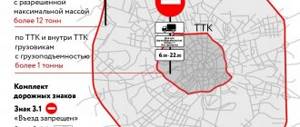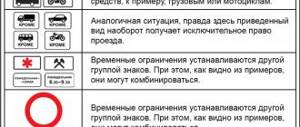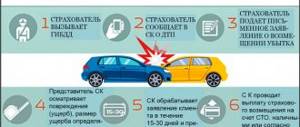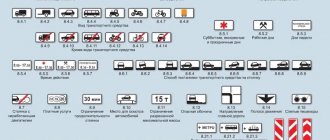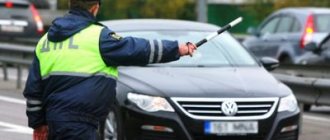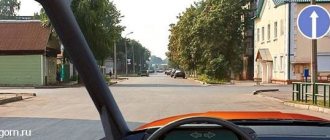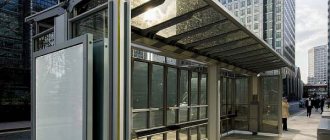Free legal consultation by phone:
8
Thousands of people die on the roads every year, usually due to non-compliance with traffic rules. Statistics for 2021 show a 10% decrease in the number of fatal accidents compared to 2021. An increase in the size of fines for drivers for traffic violations plays a significant role in the positive dynamics.
According to the traffic rules, there is a list of circumstances in which the driver is obliged to give way to persons who have the right of way.
General information
The requirement stated in the traffic rules as “give way” implies that the driver should not start or continue driving, as well as carry out other maneuvers that could entail a change in the direction of movement or speed of other highway participants who have the right of way. The advantage, in turn, is expressed in the right to priority movement in the intended direction.
The following have the right of right of way on the road:
- cars moving on the main road relative to those on the secondary road, if the corresponding road sign is installed at the intersections;
- pedestrians walking along the roadway in places marked by road signs or special crossing markings;
- special equipment, in cases where signaling equipment is turned on, for example, an ambulance, fire truck, police and other authorities with priority rights;
- cyclists preparing to make a turn;
- blind pedestrians, regardless of the crossing location, when signaling to drivers with a white cane.
Ignoring priority rights on the road may entail punishment under the Code of Administrative Offenses of the Russian Federation.
Railroad crossing - what's the difference?
The driver on his route may encounter three types of railway crossings, which are equipped with appropriate priority signs. Type one is an unregulated crossing. Such a crossing involves a complete stop of the vehicle in front of the sign, and movement can be resumed only after being convinced that there is no approaching obstacle - a train.
This measure was introduced because the driver does not have any clues (either in the form of a barrier or in the form of traffic lights) that can warn in advance about the movement of the train.
Type two is a controlled crossing, where there is a three-section traffic light and a priority sign. If the red lights come on at the first one, traffic is prohibited, stop in front of the sign or marking. If another signal is flashing, movement is permitted. The third type of crossing differs only in the presence of a two-section traffic light, the red lights of which require you to stop.
Fine failure to give way to vehicle
According to Article No. 12 of the Code of Administrative Offenses of the Russian Federation, drivers who do not give way to cars moving along the main road at an intersection are subject to administrative liability, as well as fines in the amount of 1,000 rubles. The same amount is provided for motorists who interfere with the movement of other vehicles traveling in the transverse direction. Similar situations can arise as a result of a car driving into the middle of the intersection, in the direction of movement of other vehicles, at the moment of congestion.
When maneuvering in violation of the rights of another car enjoying priority, with the exception of the cases described earlier, drivers are subject to a fine of 500 rubles or a warning (Article No. 12.14 of the Administrative Code)
Official website of the Supreme Court of the Russian Federation
Driving on the side of the road is a violation of traffic rules and this driving style deprives drivers of any advantage, including on the main road, the Supreme Court of the Russian Federation notes. He points out that in the event of an accident involving a roadside driver, the driver of the other colliding car will be found not guilty.
The crux of the matter
The highest authority was examining an accident that occurred in the Samara region: a driver filed a complaint with the Supreme Court and was fined 500 rubles because, when entering the main road from the adjacent territory, he did not give way to a car moving along it.
However, the author of the complaint noted that he did not violate the Traffic Rules, and the second participant in the accident was moving along the side of the road, and therefore did not have the right of way.
Nevertheless, the courts found that a driver who refused to give way to a traffic driver was also an offender.
The Supreme Court did not agree with the acts taken in the case.
Position of the Armed Forces
The traffic rules do stipulate that when leaving the surrounding area, the driver must give way to vehicles moving on the main road.
This means that a road user must not start, resume or continue driving, or perform any maneuver if this could force other drivers who have priority over him to change direction or speed.
The right to priority movement in the intended direction in relation to other road users is recognized as an advantage.
The Plenum of the Supreme Court of the Russian Federation, in a resolution last year, separately emphasized that violators of traffic rules, including roadside drivers, lose priority over other drivers.
“The driver of a vehicle moving in violation of the Traffic Rules along a trajectory along which movement is not allowed - on the side of the road, in the opposite direction on a one-way road - or who has entered an intersection with a prohibiting traffic light signal or a traffic controller’s gesture does not have the right of way, and other drivers, for example, leaving an adjacent territory or making a turn, do not have the obligation to give way to him,” notes paragraph 14 of the resolution of the plenum of the RF Armed Forces dated June 25, 2021.
The materials of the case under consideration contain a copy of the resolution on bringing the second participant in the accident to administrative responsibility for the fact that, in violation of the requirements of paragraph 9.9 of the Traffic Rules, he was moving along the side of the road.
Thus, the Supreme Court concludes, this driver did not have the right of way through the uncontrolled intersection.
This means that the conclusion of the police and the courts that there was an objective aspect of an administrative offense in the actions of the author of the complaint is unfounded, the highest authority believes, and therefore the Supreme Court of the Russian Federation canceled the decision of the deputy head of the traffic police department, as well as the decisions of the courts of three instances and terminated the proceedings in connection with with the absence of an administrative offense.
Alice Fox
Amount of fine if you fail to give way to a cyclist or pedestrian
A driver who fails to give way to a cyclist or pedestrian is also subject to administrative liability. In this case, the object of the offense will be road safety. The driver is obliged to give way to a pedestrian crossing the roadway, both at a regulated and non-regulated crossing.
According to the Traffic Regulations Decree of October 23, 1993, a “pedestrian” is a civilian who is outside a vehicle on the roadway, pedestrian crossing or bicycle path. Based on the definition, cyclists are also considered to be pedestrians. The amount of the administrative fine if the driver does not give way in these cases will be the same.
Responsibility for violation of Article No. 12.18 of the Code of Administrative Offenses of the Russian Federation provides for a fine in the amount of 1,500 to 2,500 rubles.
Fine for failure to give way to a car
If a car with special signals and a color scheme on the body appears nearby, you must give way and change lanes, but only if this maneuver does not violate other traffic rules. You need to assess the situation this way:
- If your vehicle is stationary at this moment, wait until a car with a flashing light passes, and only then move away.
- If the car was moving, you should stop and let it go ahead.
- When changing lanes into another lane, take into account the rules and the possibility of creating an emergency - the latter cannot be allowed.
A frequent picture that can be seen on the road is traffic police officers patrolling at intersections, punishing motorists for offenses, including if an ambulance or fire truck is involved.
What is the fine for not allowing a car with a special signal to pass in 2018?
Important: These are firefighting vehicles; we also include ambulances and police here. When such cars appear on the road, drivers are required to give way to them. Minibus taxis and buses must be allowed through within a populated area if the vehicle starts moving from a stop.
The circumstances will influence what fine you will be issued. They did not let through a special vehicle moving on the road or a car that has the right to priority - 1,500 rubles (Part 3 of Article 12.14). The traffic police officer may choose a different punishment.
We are talking about deprivation of a driver's license for 1 to 3 months.
But the measures may not be so severe if the traffic police officer limits himself to issuing a warning. Conclusion Give way to pedestrians and special vehicles.
Don't forget to give way to cyclists. If you want to know about fines on time, install SMS notifications.
Fine for refusing to give way to a car with a special signal
If there is a video recording, this will be proof that you have started the maneuver and are ready to give way.
- If a protocol is drawn up, indicate in it in your own hand: “I did not violate the rules, I was ready to give way and began the maneuver.”
- You must only allow special vehicles with a flashing light and siren on. If there is no siren, you are not required to give way.
Finally, regardless of what the protocol is being drawn up for, be sure to include witnesses in it who will confirm your innocence, and also take a copy. By virtue of Art. 28.2 of the Code of Administrative Offenses of the Russian Federation are obliged to give it to you. With a copy of the document in hand, you can continue to fight. Return Give way to pedestrians or let them pass? New rules! The episode of the “Road” program will talk about this.
What is the fine for not giving way?
Can a driver's license be revoked? If the offense was obvious, the driver will not only have to pay a fine for not allowing a car that is driving with a special signal to pass, but also lose his license for 3 months.
This is possible if the driver is stopped for violating traffic rules by a traffic police officer at the scene of the offense.
The decision cannot be appealed only if the driver did not move to another lane of the car with the beacon on; in other situations, it is quite possible to return the driver’s license.
You should not lose sight of the fact that you can lose your license if you missed a car with a special signal and at the same time violated other traffic rules - you hit a neighboring vehicle or overtook it, thereby creating an emergency situation, perhaps crossed a pedestrian crossing, letting pedestrians pass.
If you do not give way to special equipment
Special equipment refers to vehicles equipped with light and sound signals for ambulance, emergency and police assistance. Such vehicles have the right of way. Both drivers and pedestrians, cyclists and other road users must allow cars to pass.
The driver’s obligation to allow special equipment to pass arises if the warning equipment is activated.
Punishment for the offense is provided for in Article No. 12.17 of the Code of Administrative Offenses of the Russian Federation and is expressed in the form of a warning or a fine of 500 rubles. The same liability arises in case of failure to provide priority to route transport.
In a similar situation, if special equipment has not only special equipment, but also an external color system, inscriptions and designations, the punishment may be more severe, up to the deprivation of a driver’s license from one to three months.
Who doesn't need to give way?
But there are a number of cases when letting a car pass ahead means creating an emergency situation on the road. It also happens that giving in is unnecessary and even dangerous.
This is precisely what should not be done in cases where a motorist drives out of the yard onto the street. In this case, the driver who needs to enter the roadway is obliged, according to traffic rules, to let all cars pass, and only after that he has the right to make a maneuver.
In a situation where such a driver is allowed ahead, the risk of an accident increases greatly. Indeed, in this case, the motorist simply cannot correctly assess the conditions on the road due to the fact that the car passing him is blocking his view. Moreover, then other drivers moving in the traffic will not be able to see the car that is driving onto the road in time.
Also, the driver must not give way on the road to a motorist who violates traffic rules. According to the law, a motorist who violates traffic rules does not receive priority on the road, and no one is obliged to yield to him. Of course, there are often cases when not letting such a motorist pass means risking your own life. For example, it is obvious that it is better to give way to a car that is moving in the oncoming lane in violation of traffic rules, without having the right of way on the road.
In general, “to pass or not to pass” is always a decision that must be made based on the actual conditions on the road, not forgetting that there are other road users around. And sometimes “missing” will mean putting them at risk.
This is exactly what happens when, while driving on a multi-lane highway, one driver lets another pass. Often in this situation, other road users may not expect such a maneuver and will not be able to react to it in a timely and correct manner. And in this case, the driver who needs to change lanes is obliged to give way to everyone and make sure that the maneuver is safe. Otherwise, he will face a fine of 500 rubles, which is provided for in Part 3 of Article 12.14 of the Administrative Code.
Dangerous situations on the road also arise when a motorist voluntarily or involuntarily gives way to a pedestrian who is crossing the road in the wrong place.
Of course, in this case, the pedestrian violates traffic rules, putting himself and all road users at risk. And the motorist, who is sometimes forced to let such a pedestrian pass, by sharply braking, creates a threat to those driving behind him. Drivers behind cars may not have time to brake, and then everything can turn out sad for both motorists and pedestrians.
Often dangerous situations arise when a motorist does not allow a car to pass ahead as it tries to pass on the side of the road. Judicial practice shows that he should not miss it. But often a driver who is trying to make a detour along the side of the road, confident that he is right, does not want to give way to someone who has both common sense and traffic rules on his side. Often in such situations it is not possible to avoid an accident.
Of course, all motorists must adhere to the rules of courtesy on the road. However, everything should be in moderation, and in cases where safety comes first, you should not neglect the rules for the sake of etiquette.

